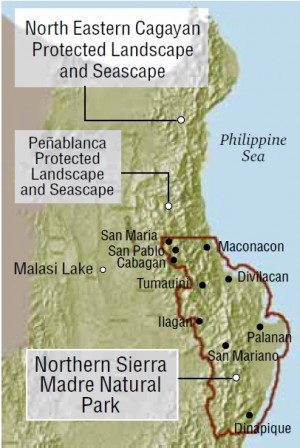Bird protection drive pushed at Sierra Madre park
PALANAN, Isabela—Roiled by the recent killing of a rare Philippine eagle in Davao Oriental province, government conservationists have tapped teachers and students as ecology guardians to help inventory and stand watch over wildlife species thriving in the 359,486-hectare Northern Sierra Madre Natural Park in this remote town facing the Pacific Ocean.
The park is the largest and most diverse protected coastal area in the country and one of the 10 priority sites of the National Integrated Protected Areas System, said William Savella, provincial environment and natural resources officer.
Pamana, a 3-year-old juvenile Philippine eagle, was found dead with a bullet wound on Aug. 19, two months after it was released into the wild on the Mt. Hamiguitan range, a Unesco World Heritage Site in Davao Oriental.
Designated a wilderness area in 1979, the Palanan rainforest was proclaimed a national park in 1997 and later renamed the Northern Sierra Madre Natural Park. It encompasses the towns of Divilacan, Dinapigue, Palanan, Maconacon, San Mariano, Ilagan, San Pablo, Cabagan, Santa Maria and Tumauini.
Conservation plan
As ecoguardians, students and teachers are taught to promote the sustainable conservation of the Northern Sierra Madre National Park’s natural resources. They are tasked with developing a conservation plan based on their fieldwork.
Article continues after this advertisement“We encourage [them], aside from the volunteers from villages, to continue their noble contribution in protecting the environment,” said Savella, a forester.
Article continues after this advertisementThe Department of Environment and Natural Resources (DENR) has identified the park’s bird habitats that are highly critical and vulnerable, monitored sightings of the critically endangered Philippine eagles, and hired forest protection officers and volunteers to help in protection drives.
At least 240 bird species have been spotted in the park’s virgin forests, including the Philippine eagle (Pithecophaga jefferyi), the Luzon Water Redstart (Rhyacornis), and the endemic Isabela oriole (Oriolus isabellae), one of the rarest birds in the world, according to Conservation International’s biodiversity surveys.

He urged people living near the park to report illegal wildlife trade and to prevent the hunting and trading of threatened species.
Nilo Domorozo, village chief of San Isidro here, said his community had been doing its part in protecting the park by reporting illegal logging activities.
In the last six months, he said, the DENR took in two eagles turned over by villagers. Banog, a locally named Philippine hawk eagle, was received by forester Samuel Berlin of the Roxas community environment and natural office.
“The [hawk eagle] is endemic to the forests of the Philippines. It can stand up to 30 inches with a wingspan twice the length of its body and it can weigh up to 2 kilograms. It perches in dense canopies and often soars,” Berlin said.
The second bird—a serpent eagle (Spilornis cheela), was turned over to the Cauayan City community environment and natural resources office last month.
“Nongovernment groups have teamed up with foresters in initiating the [biodiversity protection] project, with environment watchdogs Haribon Foundation and Biodiversity and Watersheds Improvement for Stronger Economy and Ecosystem Resilience (B+Wiser). whose workers have focused on conservation activities,” Savella said.
Haribon is a membership organization dedicated to the conservation of Philippine biodiversity while B+Wiser promotes the improvement of natural and environmental resources.